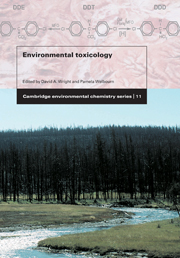Book contents
- Frontmatter
- Contents
- Foreword
- Preface
- Abbreviations
- Acknowledgements
- 1 The emergence of environmental toxicology as science
- 2 The science of environmental toxicology: Concepts and definitions
- 3 Routes and kinetics of toxicant uptake
- 4 Methodological approaches
- 5 Factors affecting toxicity
- 6 Metals and other inorganic chemicals
- 7 Organic compounds
- 8 Ionising radiation
- 9 Complex issues
- 10 Risk assessment
- 11 Recovery, rehabilitation, and reclamation
- 12 Regulatory toxicology
- 13 An overall perspective, or where to from here?
- Glossary
- Index
10 - Risk assessment
Published online by Cambridge University Press: 05 June 2012
- Frontmatter
- Contents
- Foreword
- Preface
- Abbreviations
- Acknowledgements
- 1 The emergence of environmental toxicology as science
- 2 The science of environmental toxicology: Concepts and definitions
- 3 Routes and kinetics of toxicant uptake
- 4 Methodological approaches
- 5 Factors affecting toxicity
- 6 Metals and other inorganic chemicals
- 7 Organic compounds
- 8 Ionising radiation
- 9 Complex issues
- 10 Risk assessment
- 11 Recovery, rehabilitation, and reclamation
- 12 Regulatory toxicology
- 13 An overall perspective, or where to from here?
- Glossary
- Index
Summary
The context and rationale for ecological risk assessment
Until the 1960s, the basis of environmental protection tended to come from retrospective, or after-the-fact, recognition of damage. Discoveries of abandoned waste material, the occurrence of accidents and spills, and inadvertent exposures of humans and ecosystems to toxic substances, as well as other unplanned events provided warning signs as well as environmental data on which to base future protection. This type of situation is no longer acceptable, although surprises still occur. Even with the application of more systematic approaches, until the mid 1980s, the potential for adverse effects was evaluated largely through tests for impacts, referred to as hazard assessment (e.g., acute toxicity testing, see Section 2.2.2).
Environmental management of toxic substances, indeed all kinds of environmental protection, ideally should involve putting into practice the advice of scientists and other specialists in the various disciplines that are involved. In spite of advances in our understanding of environmental toxicology, there are no rules or even guidelines for protecting the environment from potentially toxic substances that can be applied across the board: Every case has its own unique sets of conditions and problems. It is axiomatic that no situation is completely free of risk. Risk is defined as the “chance of an undesired effect, such as injury, disease, or death, resulting from human actions or a natural catastrophe” (CCME, 1996).
Prospective rather than retrospective approaches are now expected, and the planning process should have built into it measures for protecting humans and ecosystems.
- Type
- Chapter
- Information
- Environmental Toxicology , pp. 500 - 519Publisher: Cambridge University PressPrint publication year: 2002



